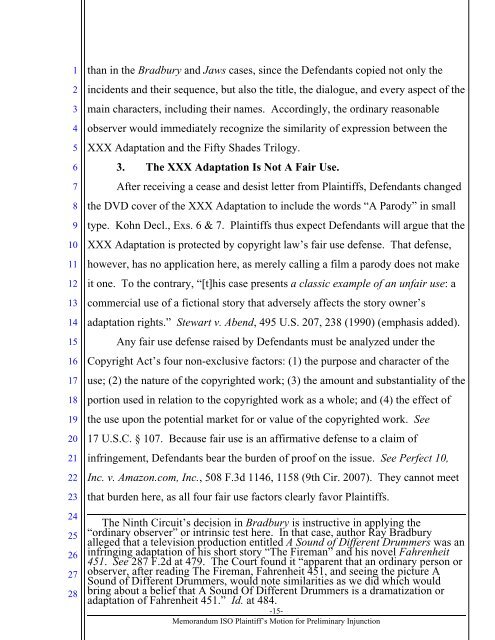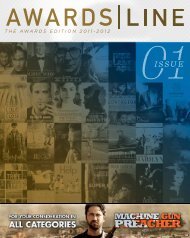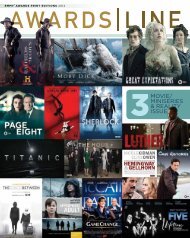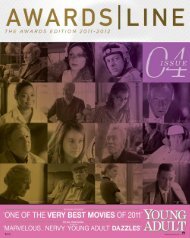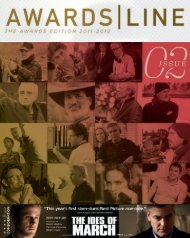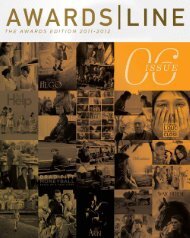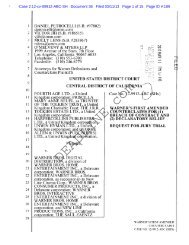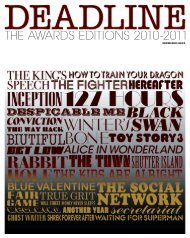Preliminary Injunction
Preliminary Injunction
Preliminary Injunction
Create successful ePaper yourself
Turn your PDF publications into a flip-book with our unique Google optimized e-Paper software.
1<br />
2<br />
3<br />
4<br />
5<br />
6<br />
7<br />
8<br />
9<br />
10<br />
11<br />
12<br />
13<br />
14<br />
15<br />
16<br />
17<br />
18<br />
19<br />
20<br />
21<br />
22<br />
23<br />
24<br />
25<br />
26<br />
27<br />
28<br />
than in the Bradbury and Jaws cases, since the Defendants copied not only the<br />
incidents and their sequence, but also the title, the dialogue, and every aspect of the<br />
main characters, including their names. Accordingly, the ordinary reasonable<br />
observer would immediately recognize the similarity of expression between the<br />
XXX Adaptation and the Fifty Shades Trilogy.<br />
3. The XXX Adaptation Is Not A Fair Use.<br />
After receiving a cease and desist letter from Plaintiffs, Defendants changed<br />
the DVD cover of the XXX Adaptation to include the words “A Parody” in small<br />
type. Kohn Decl., Exs. 6 & 7. Plaintiffs thus expect Defendants will argue that the<br />
XXX Adaptation is protected by copyright law’s fair use defense. That defense,<br />
however, has no application here, as merely calling a film a parody does not make<br />
it one. To the contrary, “[t]his case presents a classic example of an unfair use: a<br />
commercial use of a fictional story that adversely affects the story owner’s<br />
adaptation rights.” Stewart v. Abend, 495 U.S. 207, 238 (1990) (emphasis added).<br />
Any fair use defense raised by Defendants must be analyzed under the<br />
Copyright Act’s four non-exclusive factors: (1) the purpose and character of the<br />
use; (2) the nature of the copyrighted work; (3) the amount and substantiality of the<br />
portion used in relation to the copyrighted work as a whole; and (4) the effect of<br />
the use upon the potential market for or value of the copyrighted work. See<br />
17 U.S.C. § 107. Because fair use is an affirmative defense to a claim of<br />
infringement, Defendants bear the burden of proof on the issue. See Perfect 10,<br />
Inc. v. Amazon.com, Inc., 508 F.3d 1146, 1158 (9th Cir. 2007). They cannot meet<br />
that burden here, as all four fair use factors clearly favor Plaintiffs.<br />
The Ninth Circuit’s decision in Bradbury is instructive in applying the<br />
“ordinary observer” or intrinsic test here. In that case, author Ray Bradbury<br />
alleged that a television production entitled A Sound of Different Drummers was an<br />
infringing adaptation of his short story “The Fireman” and his novel Fahrenheit<br />
451. See 287 F.2d at 479. The Court found it “apparent that an ordinary person or<br />
observer, after reading The Fireman, Fahrenheit 451, and seeing the picture A<br />
Sound of Different Drummers, would note similarities as we did which would<br />
bring about a belief that A Sound Of Different Drummers is a dramatization or<br />
adaptation of Fahrenheit 451.” Id. at 484.<br />
-15-<br />
Memorandum ISO Plaintiff’s Motion for <strong>Preliminary</strong> <strong>Injunction</strong>


